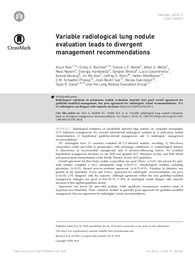Title:
Variable radiological lung nodule evaluation leads to divergent management recommendations |
Authors:
Nair, Arjun
Bartlett, Emily 
Walsh, Simon L. F.
Wells, Athol 
Navani, Neal
Hardavella, Georgia
Bhalla, Sanjeev 
Calandriello, Lucio
Devaraj, Anand
Goo, Jin Mo
Klein, Jeffrey 
MacMahon, Heber 
Schaefer-Prokop, C. M.
Seo, Joon Beom 
SVERZELLATI, Nicola  |
Editor:
European Respiratory Society |
Department:
Departamentos de la UMH::Patología y Cirugía |
Issue Date:
2018 |
URI:
https://hdl.handle.net/11000/35262 |
Abstract:
Radiological evaluation of incidentally detected lung nodules on computed tomography (CT) influences management. We assessed international radiological variation in 1) pulmonary nodule characterisation; 2) hypothetical guideline-derived management; and 3) radiologists' management recommendations.107 radiologists from 25 countries evaluated 69 CT-detected nodules, recording: 1) first-choice composition (solid, part-solid or ground-glass, with percentage confidence); 2) morphological features; 3) dimensions; 4) recommended management; and 5) decision-influencing factors. We modelled hypothetical management decisions on the 2005 and updated 2017 Fleischner Society, and both liberal and parsimonious interpretations of the British Thoracic Society 2015 guidelines.Overall agreement for first-choice nodule composition was good (Fleiss' κ=0.65), but poorest for part-solid nodules (weighted κ 0.62, interquartile range 0.50-0.71). Morphological variables, including spiculation (κ=0.35), showed poor-to-moderate agreement (κ=0.23-0.53). Variation in diameter was greatest at key thresholds (5 mm and 6 mm). Agreement for radiologists' recommendations was poor (κ=0.30); 21% disagreed with the majority. Although agreement within the four guideline-modelled management strategies was good (κ=0.63-0.73), 5-10% of radiologists would disagree with majority decisions if they applied guidelines strictly.Agreement was lowest for part-solid nodules, while significant measurement variation exists at important size thresholds. These variations resulted in generally good agreement for guideline-modelled management, but poor agreement for radiologists' actual recommendations.
|
Type of document:
info:eu-repo/semantics/article |
Access rights:
info:eu-repo/semantics/openAccess
Attribution-NonCommercial-NoDerivatives 4.0 Internacional |
DOI:
10.1183/13993003.01359-2018 |
Published in:
European Respiratory Journal. 2018 Dec 20;52(6):1801359 |
Appears in Collections:
Artículos Patología y Cirugía
|

.png)
